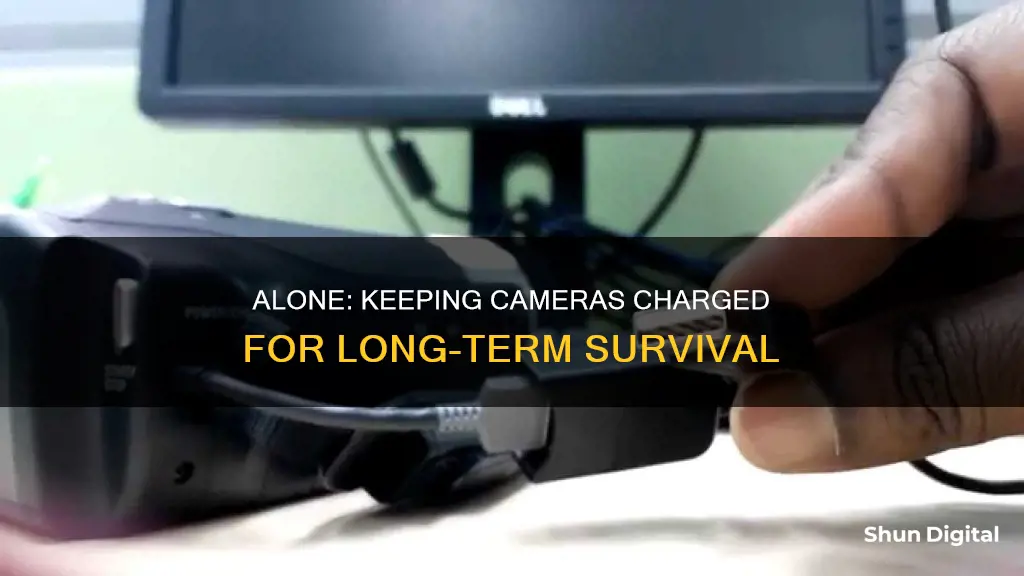
In the reality TV series Alone, contestants are left to survive in harsh and unforgiving terrains with only 10 items of their choice. They must hunt, build shelters, and fend off predators while documenting their experiences. With no camera crew following them, contestants are responsible for ensuring their cameras stay charged and operational. The show's producers have devised a system of dead drops, where contestants have a drop-off place for spent cameras and pick up newly charged ones, allowing them to continue filming without interruption.
| Characteristics | Values |
|---|---|
| Number of contestants | 10 |
| Contestants' gender | Men and women |
| Contestants' items | 10 |
| Contestants' tasks | Hunting, building shelters, fending off predators, documenting their experiences |
| Camera charging method | Dead drops |
| Dead drops | Predetermined locations where producers drop off replacement cameras and fully charged batteries |
| Contestants' visits | Weekly |
What You'll Learn
- Contestants are responsible for ensuring cameras are charged and operational
- A well-planned system of dead drops is used to swap batteries and cameras
- Contestants receive a GPS device and coordinate to locate the drop site
- Contestants pick up new equipment and leave old equipment at the drop site
- The dead drop system ensures contestants remain genuinely alone

Contestants are responsible for ensuring cameras are charged and operational
Contestants on the TV series "Alone" are responsible for ensuring their cameras are charged and operational. They are provided with cameras and several batteries when they arrive in their designated wilderness areas. However, with no access to electricity, they must rely on a well-planned system of dead drops to keep their cameras charged.
The dead drop system involves predetermined locations where producers drop off replacement cameras and fully charged batteries while collecting the used and depleted ones. These locations are communicated to the contestants via satellite, and they are given a GPS device and coordinates to locate the drop site. This ensures that the contestants remain genuinely alone in the wilderness while being able to capture their journey.
The process of charging cameras becomes a swapping process where contestants trade their old equipment for new ones. This system allows them to continue filming with minimal interruptions and gives viewers an unfiltered look at their journey and survival strategies.
To ensure they have enough power to operate their cameras, contestants must be mindful of their battery usage and plan their trips to the dead drop sites accordingly. While the dead drop system provides support, the responsibility ultimately lies with the contestants to manage their camera equipment and ensure it is functional.
By prioritising the charging and maintenance of their cameras, contestants can effectively document their experiences in the wilderness, showcasing their resilience and survival skills for the world to see.
Charging Your Fujifilm Camera: A Step-by-Step Guide
You may want to see also

A well-planned system of dead drops is used to swap batteries and cameras
In the reality TV series "Alone," contestants are left in a remote wilderness area with minimal equipment and must survive for as long as possible. The show is unique in that there are no camera crews following the contestants, who are tasked with documenting their experiences themselves. This raises the question of how the cameras they use stay charged. The answer lies in a well-planned system of dead drops.
When contestants arrive at their designated locations, they are provided with cameras and several batteries. It is their responsibility to ensure the cameras remain charged and operational. To facilitate this, the show's producers have devised a system of dead drops, which are predetermined locations where contestants can pick up replacement cameras and fully charged batteries. These dead drop sites are carefully selected and communicated to the contestants via satellite, ensuring that they remain genuinely alone in the wilderness.
The contestants are given a GPS device and coordinates to locate the drop-off site. They are instructed to reach the location when they require new batteries or cameras. Once they arrive, they can safely pick up their new equipment without any contact from the outside world. This process is more of a swapping system, as contestants must leave their old batteries and used cameras behind for the production team to collect.
This well-planned system ensures that contestants can continue filming their journey without technical difficulties interrupting them. It also allows viewers to experience an unfiltered view of the contestants' struggles and adaptations to their harsh environments. The dead drop system is a crucial aspect of the filming process, enabling the show to capture the essence of the contestants' journeys while maintaining the integrity of their isolation.
Charging Camera Batteries: Alternative Methods to Try
You may want to see also

Contestants receive a GPS device and coordinate to locate the drop site
In the reality TV show "Alone", contestants are given a list of survival items, including several cameras, lights, batteries, a satellite phone, and a GPS tracking device. The contestants are also provided with a large box filled with camera gear and batteries.
Contestants receive a GPS device and a set of coordinates to locate the drop site, where they will be resupplied with new batteries and memory cards. This typically occurs every week or two, during medical check-ups. The GPS device also serves as a safety measure, allowing the crew to locate and assist contestants in case of a serious injury or emergency.
The GPS device is not meant for contestants to navigate their surroundings but rather for the crew to monitor their location and ensure they stay within the designated boundaries of their zone. Contestants are notified through a warning alert or a text message on their satellite device if they are approaching the boundary.
In addition to the provided gear, contestants are allowed to choose 10 additional survival items from a list of 40 options, including hunting knives, sleeping gear, cooking equipment, fishing gear, and more. These items are crucial for their survival and documentation of their experiences in the wilderness.
Samy's Camera and Texas Sales Tax: What's the Deal?
You may want to see also

Contestants pick up new equipment and leave old equipment at the drop site
Contestants on the TV series "Alone" are provided with cameras and several batteries when they arrive at their designated wilderness areas. However, they are responsible for ensuring the cameras remain charged and operational throughout their journey. To facilitate this, the show's producers have devised a system of dead drops.
Dead drops refer to predetermined locations where contestants can pick up replacement cameras and fully charged batteries. Simultaneously, they leave their used cameras and depleted batteries for the production team to collect. These locations are communicated to the contestants via satellite, and they are provided with a GPS device and coordinates to locate the drop site.
The system is carefully planned to ensure contestants remain genuinely alone in the wilderness. Once contestants arrive at the drop-off location, they can safely collect their new equipment without any contact from the outside world. This process is a crucial aspect of the filming, allowing the contestants to continue documenting their journey with minimal interruptions.
The charging process, therefore, becomes a swapping system, ensuring contestants are always equipped with functional equipment to capture their experiences in the remote and isolated wilderness.
Eufy Camera Charging: Mounting Prep or Not?
You may want to see also

The dead drop system ensures contestants remain genuinely alone
The History Channel's show "Alone" is a survival reality show where contestants are left alone in the wilderness with only 10 selected items to survive. The contestants must hunt, build shelters, and fend off predators, all while documenting their experiences themselves. The show's premise is that the contestants are left "alone" in the wilderness, but how do the cameras they use stay charged?
The dead drop system, a method of espionage tradecraft, is used to ensure contestants remain genuinely alone and their cameras stay charged. A dead drop is a way to pass items or information between two individuals without meeting directly, thus maintaining operational security. In the case of "Alone", the contestants would have a secret location where they would pick up fully charged camera batteries and drop off the used ones. This ensures that the contestants remain alone and that the production team can regularly check on their footage.
The dead drop system has been used for decades by intelligence agencies and is still relevant in the digital age. It is a way to control exactly how and when a package is delivered and who has the ability to pick it up. In the case of "Alone", the dead drop system is a way to ensure that contestants have the necessary camera equipment to document their experiences without having direct contact with the production team.
The use of the dead drop system in "Alone" ensures that the contestants remain genuinely alone and that the production team can regularly collect footage. This system allows for the show's premise of leaving contestants alone in the wilderness to be maintained while also ensuring that the contestants have the necessary equipment to document their experiences.
How to Prepare Your Polaroid Camera for Instant Shots
You may want to see also
Frequently asked questions
The contestants are provided with a GPS device and coordinate to locate a drop-off site where they can pick up newly charged cameras and replacement batteries.
Contestants receive new batteries and USB cards during their weekly medical check-ups.
While the producers prepare a dead drop of batteries and replacement cameras, it is the contestants' responsibility to ensure the cameras are charged and operational.
The contestants do not have access to electricity to charge their cameras. Instead, they rely on the dead drop system, where they swap their old equipment for newly charged ones.







